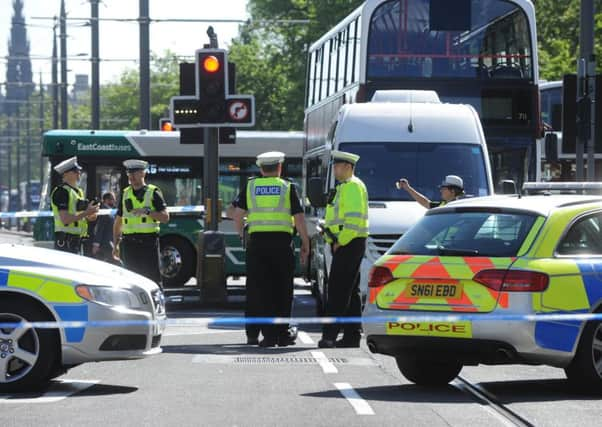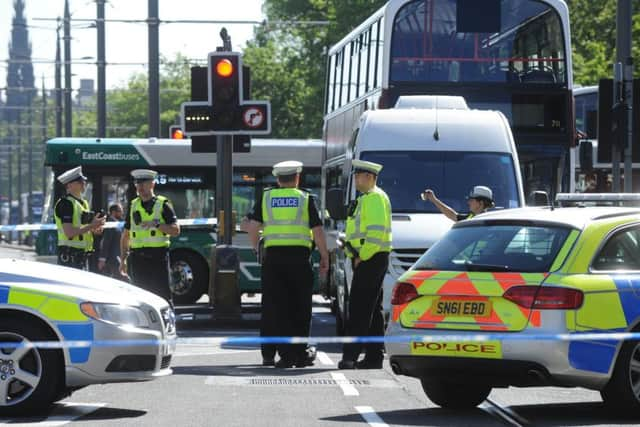'˜This has been a fatality waiting to happen'


A 24-year-old woman died in hospital yesterday after she was hit by a minibus after falling off her bicycle when its wheels apparently became stuck in tram tracks.
The crash happened at the junction of Princes Street and Lothian Road in Edinburgh at around 8:30am.
Advertisement
Hide AdAdvertisement
Hide AdHer death comes five years after campaigners branded Princes Street a “death trap” because of the lack of a designated cycle lane and happened on the third anniversary of the tram line opening.


Some 200 cyclists have been injured by tram tracks in Edinburgh at a cost to the NHS approaching £1 million.
Solicitors representing 141 of the injured who are suing the city council said they called for urgent action two years ago.
Pedal on Parliament (PoP), which organises an annual lobby of MSPs over cyclist safety, said urgent action was required. Spokesman Kim Harding said: “We have been saying for years that the tram/cycle infrastructure between Princes Street and Haymarket is totally inadequate.
“This is the collision we all feared would happen. It was never a question of if it would happen, it has always been a question of when it would happen.


“The design has been a fatally waiting to happen. This sad death was completely avoidable.
“It is now time that the safety of cyclists and pedestrians was taken seriously.”
A Cycling UK spokeswoman said: “There are several notorious tramline blackspots for cycling in Edinburgh, with road and tram line designs posing serious hazards for people cycling, as hundreds of injuries and now this tragic and avoidable death demonstrate.
Advertisement
Hide AdAdvertisement
Hide Ad“People who cycle should not have to share space with trams and other vehicles.”
Dr Chris Oliver, an orthopaedic surgeon at Edinburgh Royal Infirmary, said some of the 191 cyclist injuries on tram tracks he had collated had suffered permanent disability.
He said: “The overall problem is the lack of enough forethought to build in good cycling infrastructure when the tram line was constructed. The design was poor from the outset. To retrofit that would be very expensive.”
Cycling injuries on tram tracks have also raised concerns in English cities with tram networks such as Manchester and Nottingham.
In Croydon, a man died four years ago when his bike slipped on tracks and he fell into the path of a bus.
However, in Edinburgh both campaigners and the city council cast doubt over whether rubber or metal inserts in tram tracks were a viable solution.
Dave Holladay, a transport specialist with knowledge of this area, said it would be very costly.
He said tracks would have to be replaced, and it could not be used on tight curves. However, he said tests were being carried out on a high-friction surface that could potentially be laid beside tracks to help prevent bicycle wheels slipping into them.
Advertisement
Hide AdAdvertisement
Hide AdMr Harding, of PoP, said: “Rubber inserts could be used to reduce the risk of wheels becoming trapped, but there would still be a slip risk.
“What is really needed is a separated cycle lane, following best international practice.”
The city council said insert material had not worked elsewhere, partly because it could not take the weight of trams.
A city council spokeswoman said: “Our thoughts are with the family and friends of the young woman.
“We cannot speculate on the circumstances of the accident, but we will work with Police Scotland as they continue their investigations.”
The council has previously said: “Cycle safety is of utmost importance and we have gone to every effort to raise awareness of the impact of the tram on all road users.
“We have carried out extensive awareness-raising activity, much of which has focused specifically on cyclists.
“As part of this, markings were added to the road at Haymarket to direct cyclists along the safest possible routes.
Advertisement
Hide AdAdvertisement
Hide Ad“Like many other European cities, Edinburgh now incorporates both cyclists and trams and cyclists are advised to take care when travelling near the tram tracks.”
The council urged extra care in wet weather when tracks were slippery, and advised cyclists to cross them as close to a right angle as possible.
However, Prof Oliver said many of the injured cyclists said they had been prevented from doing this because of the proximity of other vehicles.
But he said people should not be put off cycling as its health benefits outweighed the risks by 20 to one.